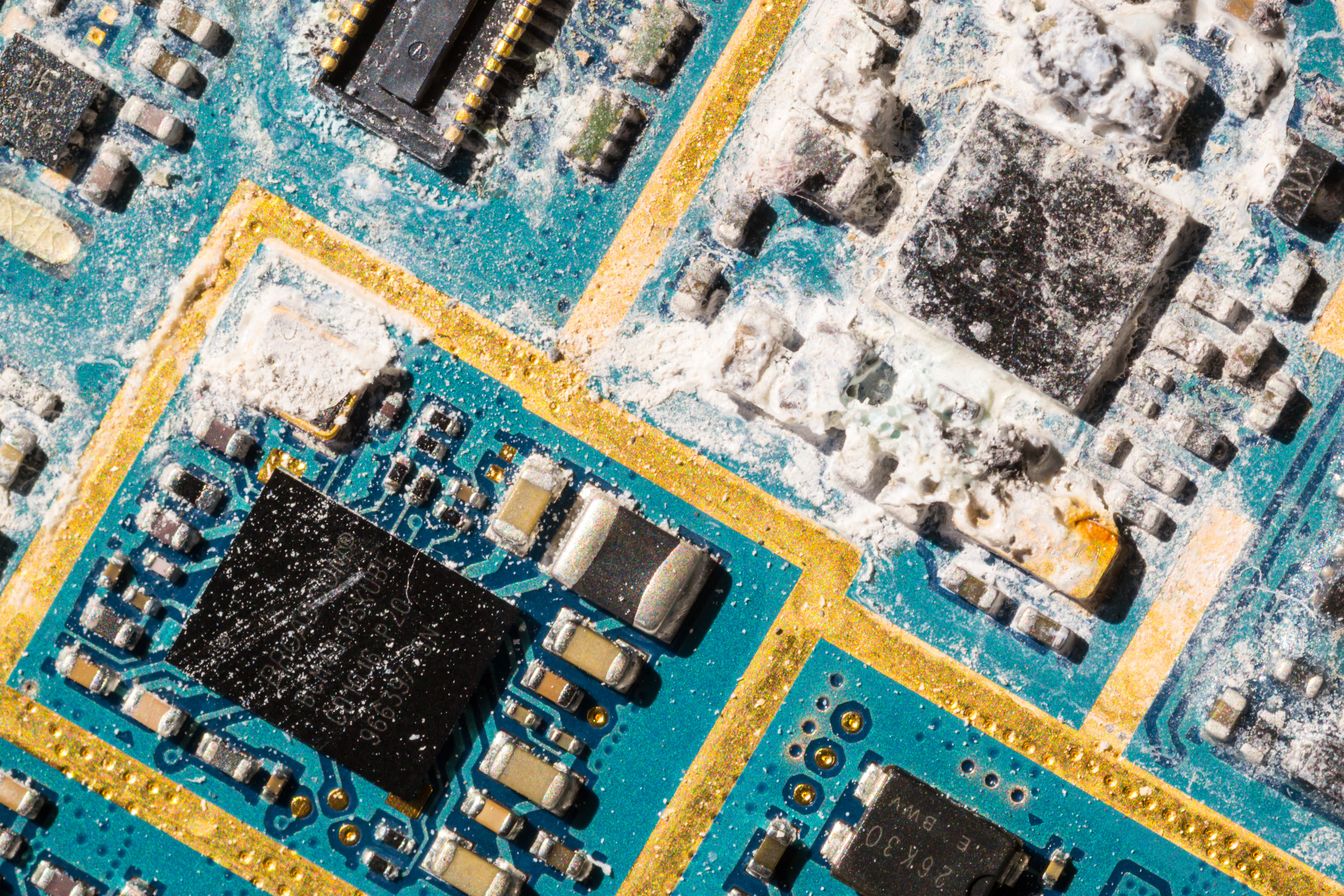Three reasons why cleaning no-clean flux is essential for today’s PCBs
It is estimated that over half of the printed circuit boards (PCBs) made today use no-clean solder paste during assembly. Some PCB fabricators believe that it speeds up the production process by removing the need for cleaning circuit boards after reflow.
However, as PCBs become more complex and tightly packed with components, some are discovering that no-clean soldering paste does not work well with today’s delicate circuitry. Elizabeth Norwood, Senior Chemist at MicroCare, LLC, further discusses.
Today’s demand for smaller electronics is forcing fabricators to squeeze micro components like flip chips, micro BGAs and CSP and QFN integrated circuit packages into tighter spaces on the boards. Low standoff components like MOSFETs are commonplace. I/O (input/output) counts are increasing and circuit boards are now multi-layered. This trend in circuit board miniaturisation, complexity and high density may cause a greater likelihood for problems if the PCBs, especially those produced using no-clean solder pastes, are not properly cleaned.
A difficult cleaning challenge
The irony of no-clean fluxes is that they were supposed to ease the need for PCB cleaning. Unlike other fluxes, no-clean flux is intended to stay on the board with no cleaning or flux removal required. However, when the salt activators in the no-clean flux come in contact with heat or other chemicals, they leave behind an unsightly white residue that may corrode fragile circuits and promote dendrite growth. This white residue is some of the most stubborn and difficult contamination and one of the most difficult PCB cleaning challenges.
Dirty PCBs can be vulnerable to many types of problems including parasitic leakage, electrochemical migration, shorting and dendrite growth. In many cases, the need to clean no-clean flux residue is no longer optional. It is essential for three reasons: long-term PCB performance, PCB appearance and PCB reliability.
 White residue: White residue is some of the most stubborn and difficult contamination to remove
White residue: White residue is some of the most stubborn and difficult contamination to remove
Help ensure board performance
As modern PCBs continue to become more complex, many assemblers today may choose to clean all their PCBs, not just the high-reliability boards. Preventing unpredictable performance, costly board failures, product recalls and product returns is a big motivator. So, despite the advent of no-clean soldering, many manufacturers are still cleaning all their boards.
The primary reason to remove no-clean flux and its residue is to prevent malfunctions in circuits and to prevent interference with signal transmission. For instance, if too much no-clean flux builds up on a circuit board, or if white residue is left behind, it can create noise on the board, especially on high-voltage systems.
Some PCB manufacturers are also finding that that no-clean flux residue may prevent proper conformal coating adhesion. This is a real problem for circuit boards that are used outdoors or in other harsh environments. Flux residue adsorbs moisture. This trapped moisture may then be released during curing operations, causing the conformal coating to separate from the board. This can allow contaminants, dust, or water to penetrate the PCB causing corrosion, intermittent signal transmission, or even complete PCB failure. Comprehensive removal of no-clean flux residue prior to conformal coating may help prevent this from happening.
Reflect on appearance
Cosmetic appearance is the second reason why fabricators, especially those manufacturing for consumer products, choose to clean their no-clean from their circuit boards. White flux residue looks dirty and messy and may be misconstrued to represent careless or sub-par work. Cleaning the flux residue from circuit boards may help make them more visually appealing and more acceptable for customers.
Boost your reliability odds
Thirdly, no-clean flux and leftover residue may make inspections difficult. QC (quality control) inspections and troubleshooting field repairs may become more challenging if flux residue is left on the circuit boards. It can also cause automated visual alignment systems to fail. By thoroughly cleaning no-clean fluxes it may help make PCB inspections easier and more accurate. Therefore, ensuring a more reliable and long-lasting PCB.
Best practices in cleaning
When cleaning no-clean fluxes there are some best practices, that may help PCB makers get quality cleaning results along with the PCB performance, appearance, and longevity they expect.
Traditionally, many PCB designers and engineers didn’t think about PCB cleaning until the very end of the design process. But as PCBs become more complex, they are recognising the need to determine their cleaning options earlier in the design process; before decisions about coatings, solder pastes and other materials are finalised. It can be much easier to resolve any cleaning problems with early fluid specification prior to production. This is especially true when manufacturing high-reliability PCBs, such as medical or military products where cleanliness is critical or where validation processes or other stringent customer requirements are outlined.
 Inspection: Leftover flux residue may make inspections difficult
Inspection: Leftover flux residue may make inspections difficult
In addition, PCB fabricators are finding it beneficial to produce and test-clean small batches of PCBs first. Once the cleaning fluid and process are proven to work on a smaller scale, then they scale-up into full production mode. Through this small-batch preemptive testing, they are minimising surprises and ensuring better board reliability before it becomes a major headache. Here are some other best practice tips to ensure clean and reliable PCBs.
Follow recommendations
For best results in both soldering and cleaning, it is important to follow the solder paste manufacturer's recommended reflow process. Exposing no-clean solder pastes to extreme heat may cause the flux residue to darken and solidify, making the baked-on flux harder to remove. The oven needs to be hot enough to cure but not so hot that it burns the flux to the point it cannot be cleaned.
Check materials compatibility
No-clean flux removers are available in a variety of strengths. Assemblers should choose a cleaning fluid by carefully matching the fluid to the contaminant to be removed. In addition, the cleaning fluid should be compatible with the PCB substrate and other materials on the board. Start with a flux remover with a low Kb value (strength) and work up until the right strength to use. The flux remover should be strong enough to effectively remove the flux residue, yet not cause damage to metal, plastics or coatings.
Choose tools for safety
When possible, PCB assemblers should choose a nonflammable no-clean flux remover for workplace safety. Also, using a cleaning fluid dispensing tool can easily scrub away contaminants and help boost worker safety by regulating the amount of fluid and fumes workers are exposed to.
Keep your options open
If a PCB fabricator is still having trouble with a no-clean residue, it might be time to try a different cleaning fluid or even a different no-clean solder paste. They could try a paste with less solids or resins in the flux. The lower the solids content, the lower the flux residues left on the board, making it easier to clean. Also, a no-clean flux with fewer halides may be easier to remove. If all else fails, they may consider switching to a different solder paste that is more cleanable. There are manufacturers that can provide cleaning fluids for several flux residues including everything from water-based and lead-free to R, RA, RMA, OA and SA fluxes.
Ask an expert
Companies looking for help in determining the correct cleaning fluid or method to use should consult with a critical cleaning partner that specialises in cleaning no-clean flux residue. Some cleaning fluid manufacturers have field engineers that run on-site audits to evaluate cleaning methods. Some companies have also conducted comprehensive, in-lab cleaning tests with some of the industry’s most popular solder pastes and fluxes to ensure cleaning success. Rely on those manufacturers to recommend the cleaning fluids and methods that will work best.


